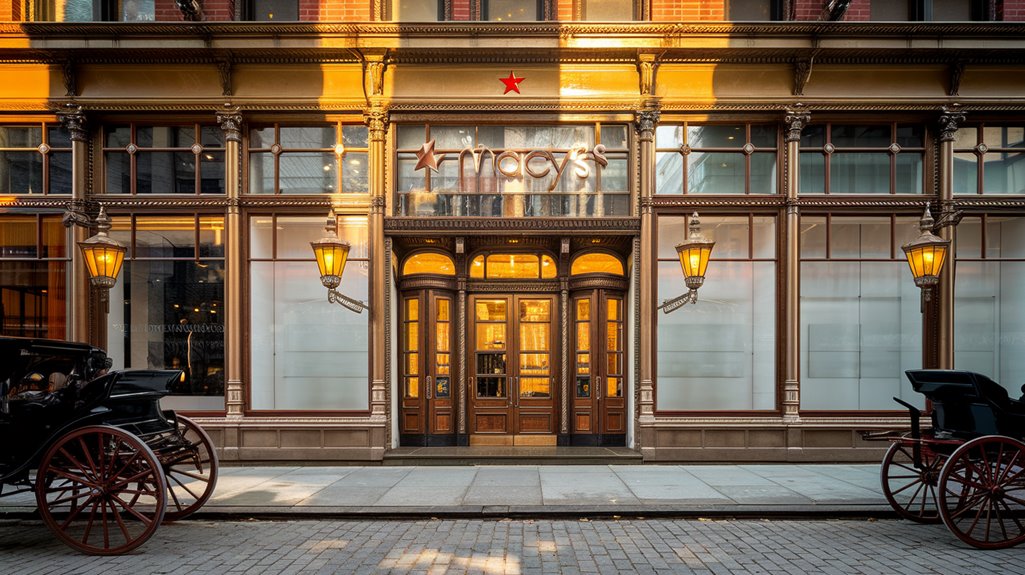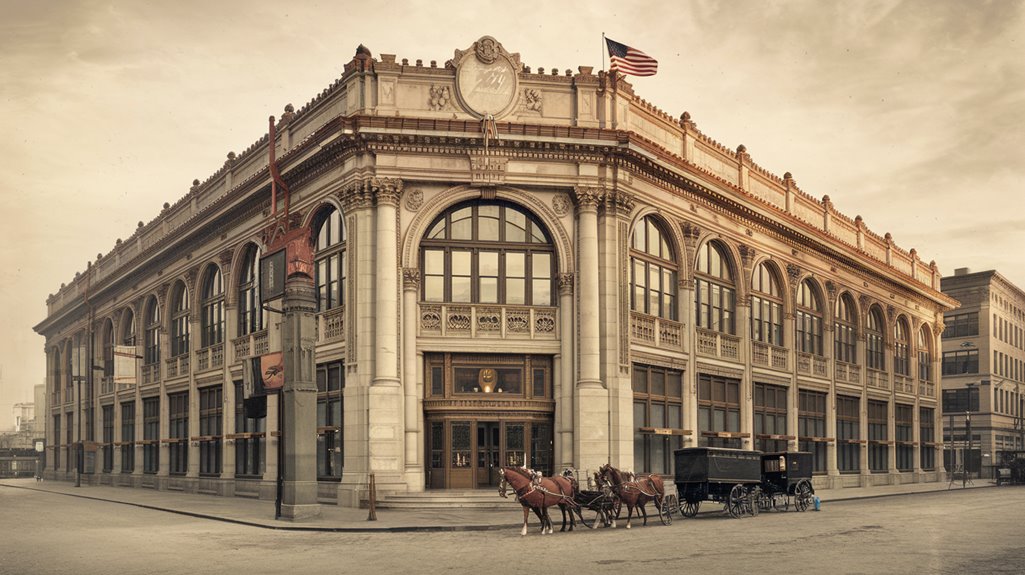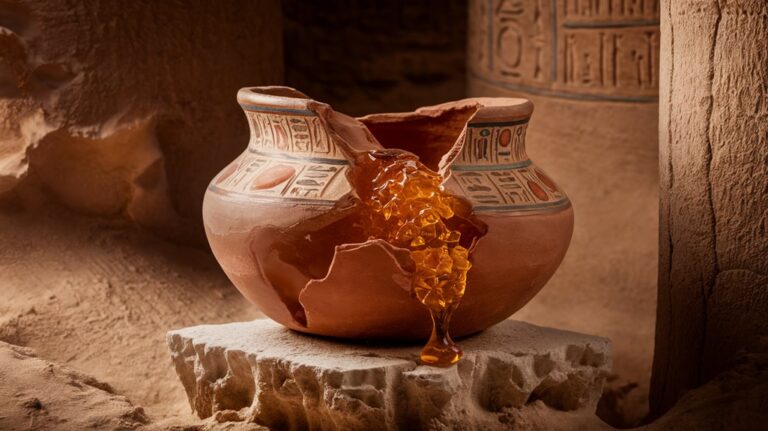Macy’s Establishment Predated the Ottoman Empire’s Collapse
When Macy's was opening its doors in New York, the Ottoman Empire was closing its chapter of dominance. You'll find it fascinating how these two entities, though worlds apart, intersect at a pivotal moment in history. As America's retail landscape transformed through Macy's innovations, the Ottoman Empire grappled with modernization and decline. This contrast between rise and fall offers unique insights into how commerce, culture, and power shifted during the 19th and early 20th centuries. Let's explore what happened next.
The Birth of an American Retail Icon
While many early American businesses struggled to survive, Rowland Hussey Macy persevered through four failed retail ventures before establishing his iconic store in New York City in 1858.
When you look at Macy's history, you'll find that the humble dry goods store on Sixth Avenue between 13th and 14th Streets generated just $11.08 on its first day – equivalent to about $390 today.
The retail evolution of Macy's began as the store quickly outgrew its original space, expanding into neighboring buildings. In 1895, the Straus brothers purchased the company and led it through a significant period of growth and modernization.
Macy's original rooster emblem was replaced by its now-famous red star in 1862.
The business proved so successful that by 1902, it relocated to Herald Square, and by 1924, it had become the world's largest department store after completing its Seventh Avenue addition. This same year marked the debut of the Macy's Christmas Parade, which would later become the beloved Thanksgiving Day tradition we know today.
Ottoman Empire's Final Years
As the 20th century dawned, the Ottoman Empire entered its final, turbulent decades marked by military defeats, political upheaval, and economic decline.
You'd have witnessed the empire's rapid deterioration through devastating military defeats in the Italo-Turkish and Balkan Wars, resulting in massive territorial losses across North Africa and Europe. A staggering Ottoman public debt of $716 million, with France holding the majority share, crippled the empire's finances.
The empire's chronic economic crisis stemmed from its failure to modernize and adapt to industrial changes, while political unrest manifested in multiple coups and the Young Turk Revolution. The once-mighty empire had fallen far from its golden age under Suleiman, which many considered its peak of power and prosperity.
Ethnic tensions reached their peak as the Committee of Union and Progress conducted genocides against Armenian, Assyrian, and Greek populations.
Modernization failures in the military and economic sectors left the empire vulnerable to European powers.
The Treaty of Sèvres ultimately carved up the remaining Ottoman territories, leading to the empire's dissolution and Turkey's establishment in 1923.
A Timeline of Historical Overlap
The historical coexistence of Macy's and the Ottoman Empire offers a fascinating perspective on the overlap between retail innovation and geopolitical decline.
While the Ottoman Empire was experiencing its final decades amid cultural influences from the West, Macy's was establishing itself as a revolutionary force in American retail. The company's first day of business saw sales of $11.08, marking a humble beginning for what would become a retail giant.
You'll find it interesting that when R.H. Macy opened his New York store in 1858, the Ottoman Empire had already existed for over 550 years. The store's innovative approach included being the first to introduce a retail Santa in 1862.
As economic shifts weakened the Empire's grip on power throughout the 1870s, Macy's was growing stronger, moving to Herald Square in 1902.
The contrast couldn't be more striking: by 1922, when the Ottoman Empire finally collapsed, Macy's was thriving and would soon become the world's largest store with its 1924 expansion.
Legacy and Historical Significance
Since its humble beginnings as a dry goods store in 1858, Macy's has shaped American retail culture through groundbreaking innovations and enduring traditions.
You'll find the store's legacy impact most visible in its iconic Herald Square location, which remains one of the world's largest department stores. The flagship store's 1.1 million square feet of retail space demonstrates its massive scale and influence.
The company's cultural significance extends far beyond retail, as evidenced by two of New York City's most celebrated events: the Macy's Thanksgiving Day Parade, running since 1924, and the 4th of July Fireworks, which they've sponsored since 1976.
Macy's pioneered the concept of "window shopping" with their elaborate holiday displays, forever changing how stores attract customers.
They've also maintained lasting traditions like on-site dining and tailoring services, reinforcing their position as a cornerstone of American retail heritage.
The Retail Revolution During Empire's Decline

During the Ottoman Empire's economic decline, dramatic shifts in global trade patterns revolutionized retail across its territories.
You'll find that retail innovation emerged as European manufactured goods flooded Ottoman markets through liberal trade policies, particularly after the Capitulations agreements.
These economic shifts coincided with the establishment of modern retail giants like Macy's in 1858, highlighting the contrast between Western commercial advancement and Ottoman deindustrialization.
The empire's global trade increased by ten to sixteenfold in the 19th century, though this growth lagged significantly behind worldwide commerce.
As you examine this period, you'll notice how traditional Ottoman industries struggled to compete with cheaper European products.
The empire's transformation from a major trading power to primarily an exporter of raw materials changed local retail landscapes dramatically. The widespread economic hardships and inflation severely impacted trade as precious metals flowed into Europe, destabilizing local markets.
Foreign merchants and Ottoman non-Muslims dominated international trade, while urban workers and peasants faced increasing economic hardship amid rising commodity prices.
 Armenian genocide from 1914 to 1923 marked one of the darkest chapters in the empire's final years.
Armenian genocide from 1914 to 1923 marked one of the darkest chapters in the empire's final years.
The empire's decline accelerated through World War I, while Western retail continued to evolve. The Ottoman Empire's fate was sealed with the Treaty of Lausanne, marking its territorial dissolution in 1923.










